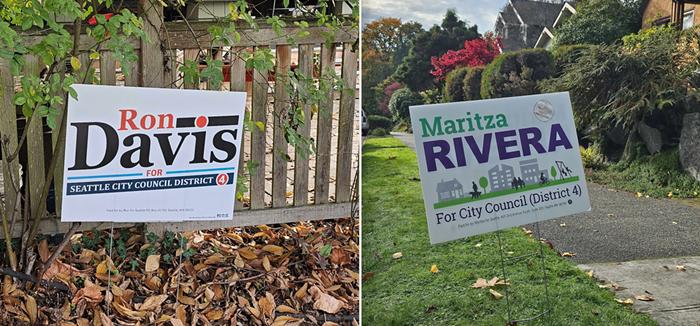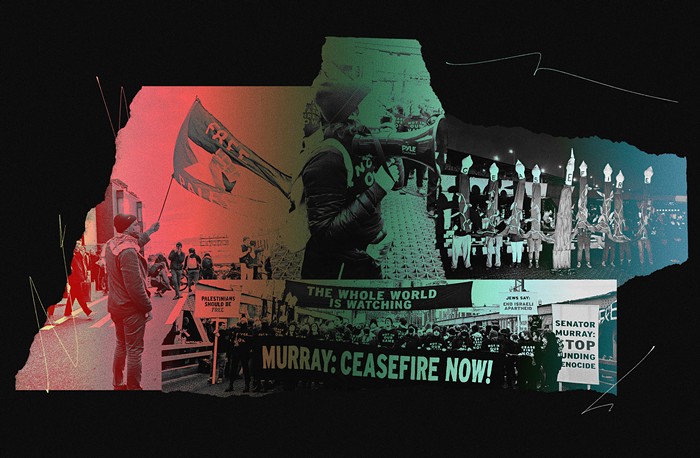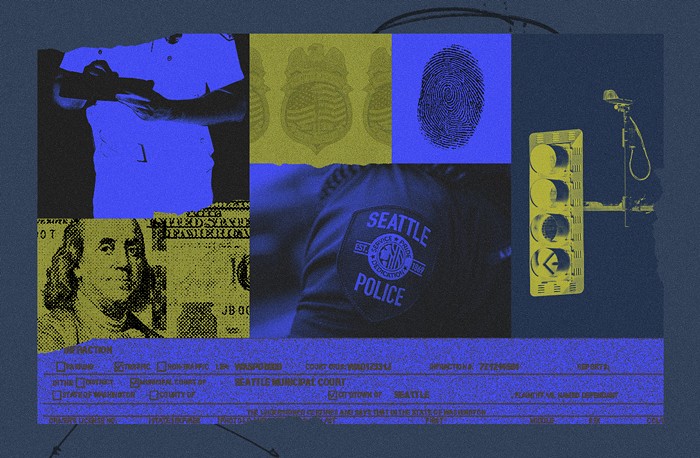That night, as workers mulled outside guild headquarters at Fairview and Harrison, the look of grim uncertainty was clearly etched on many faces, a sharp contrast to the indignant, energetic expressions the guild wanted everyone to see. An incident that illustrated the tension occurred when Larry Hatfield of the Pacific Northwest Newspaper Guild stood under a light pole and started doing what union leaders do best--leading the masses in protest. Barking into his megaphone and beginning a chant, Hatfield was beginning to move the crowd when a tall, white-haired man raised his hand in another kind of protest.
"Oh, no, no. You know this is a serious issue," the lanky man admonished huffily. "This is not something to be cheering about. We have a lot of serious issues at stake, and I don't see the point of this." A small knot of people standing nearby congratulated "Steve" for returning "reason" to the masses.
Steve would not give his last name, but he and his sympathizers clearly represented one faction in the guild. These guild dissidents were not rank-and-file circulation workers or salespeople. They were experienced Times copy editors, upper-crust members of the paper's newsroom.
For now, 10 days into the paper strike, things still seem unified. Some employees have broken through the picket line, and that's inevitable. But what the newspaper guild will have to be on guard for is not a rush of Pinkerton-style guards out of the Times building. It will be the revived chords of disunity among the better-paid editorial staff members like Steve--the veteran copy editors, reporters, and photographers of the Times and P-I.
Yes, some of the two newspapers' biggest stars--P-I sports columnist Art Thiel and Times investigative reporter Duff Wilson among them--are honoring the strike in solidarity with the brethren who toil away in the sales and circulation departments. But there is also a core group of editorial members who jumped into strike waters reluctantly, only to shriek when they realized just how cold it could get. These editorial employees had believed that an actual strike would never happen, and they were shocked to learn just how emotional the issue was for everyone else. During the fateful guild meeting in which a strike was called, they had begged for "cooler heads" to prevail, only to be drowned out by others.
Normally loquacious, the elite of the Times and P-I newsrooms talk of guild division only in off-the-record conversations, if at all. But it's well known that since the strike began, at least two private, difficult meetings have taken place at the house of Times environmental reporter Ross Anderson in Leschi. The meetings were organized for doubting editorial members, and attendance swelled from 50 to 100 people. Some describe these separate meetings as group support sessions for the educated, middle-class workers who prefer serious dialogue over the guild's rah-rah rallies.
Other described the meetings in somber tones. "There were a lot of tears from grown men," one attendee said of the second Anderson meeting, which lasted three hours. Speeches at these meetings have been lackluster in nature, like those of P-I cartoonist David Horsey, who reportedly said "he didn't want to do this but knew he had to."
Times and P-I management have already tried to exploit this division. (Technically, there's about an even split between editorial and non-editorial strikers, but the veteran class of editorial is roughly just 11 percent of all strikers.) On the first day of the strike, editors from both papers called reporters, copy editors, and photographers at their homes. The content of the calls has been consistent: Return to work tonight and all will be forgiven. "The phone calls kinda freaked people out," confirms Yoko Eidsmore, a Times copy editor-turned-picket-line- captain. The guild has filed a complaint about this tactic with the National Labor Relations Board.
In fact, Times publisher Frank Blethen tried to manipulate the worker disunity before the strike even began. Blethen wrote a single-spaced, two-and-a-half-page letter to one Times reporter (sources won't give her name). The publisher explicitly pleaded with the reporter not to participate in any kind of job action, and he wondered how the guild could come between employees and the Blethen "family."
As initial media interest in the strike dies away, strikers are settling in for what could be a long time away from work. Maintaining unity will be difficult, and it's been made even harder by the fact that Teamsters Local 763,

















